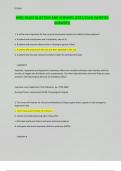ARDS NCLEX
ARDS NCLEX
All 61 resultados
Ordenador por
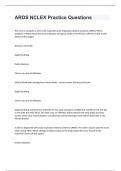
-
ARDS NCLEX Practice Questions well answered 2024
- Examen • 12 páginas • 2024
-
Disponible en paquete
-
- 15,13 €
- + aprende más y mejor
ARDS NCLEX Practice Questions The nurse is caring for a client with suspected acute respiratory distress syndrome (ARDS). Which symptom of ARDS should the nurse anticipate will appear within 24 to 48 hours after the initial insult? (Select all that apply.) Shortness of breath Rapid breathing Fluid imbalance Chest x-ray clear of infiltrates Arterial blood gases varying from normal limits - correct answer Shortness of breath Rapid breathing Chest x-ray clear of infiltrates ...
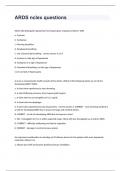
-
ARDS nclex questions with correct answers graded A+ passed
- Examen • 10 páginas • 2024
-
Disponible en paquete
-
- 17,02 €
- + aprende más y mejor
ARDS nclex questions Which S&S distinguish hypoxemia from hypercapnic respiratory failure? SATA a. Cyanosis b. Tachypnea c. Morning headache d. Paradoxical breathing e. Use of pursed lip breathing - correct answer A, B, D A: Cynosis is a late sign of hypoxemia B: Tachypnea is a sign of hypoxemia D: Paradoxical breathing is a late sign of hypoxmeia C & E are S&S of Hypercapnia A nurse is reviewing the health records of five clients. Which of the following clients are at risk for ...
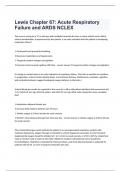
-
Lewis Chapter 67: Acute Respiratory Failure and ARDS NCLEX fully solved 2024
- Examen • 26 páginas • 2024
-
Disponible en paquete
-
- 18,91 €
- + aprende más y mejor
Lewis Chapter 67: Acute Respiratory Failure and ARDS NCLEXThe nurse is caring for a 27-yr-old man with multiple fractured ribs from a motor vehicle crash. Which clinical manifestation, if experienced by the patient, is an early indication that the patient is developing respiratory failure? A Tachycardia and pursed lip breathing B Kussmaul respirations and hypotension C Frequent position changes and agitation D Cyanosis and increased capillary refill time - correct answer C Frequent po...
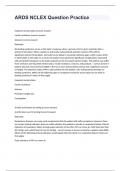
-
ARDS NCLEX Question Practice well answered 2024
- Examen • 8 páginas • 2024
-
Disponible en paquete
-
- 12,29 €
- + aprende más y mejor
ARDS NCLEX Question PracticeImpaired mental status (correct answer) Insulin resistance (correct answer) Seizures (correct answer) Rationale: Re-feeding syndrome occurs as the body's response when a person is fed or given nutrients after a period of starvation. When a patient is extremely malnourished and then receives TPN with its significant nutrient formulation, the body has to adjust to receiving nutrients again, which causes shifts in electrolytes in the body. As a result, the patient m...
ARDS NCLEX QUESTION AND ANSWERS (2023/2024) (VERIFIED ANSWERS)
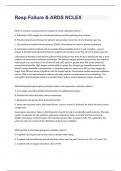
-
Resp Failure & ARDS NCLEX correctly answered rated A+
- Examen • 8 páginas • 2024
-
Disponible en paquete
-
- 12,29 €
- + aprende más y mejor
Resp Failure & ARDS NCLEXWhich is a proper nursing action for a patient in acute respiratory failure? A. Administer 100% oxygen to an intubated patient until the pathology has resolved. B. Provide chest physical therapy for patients who produce more than 30 mL of sputum per day. C. Use continuous positive airway pressure (CPAP) if the patient has weak or absent respirations. D. Administer packed red blood cells to maintain the hemoglobin level at 7 g/dL or higher. - correct answer B. Provide...
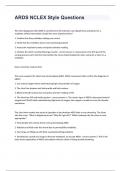
-
ARDS NCLEX Style Questions well answered
- Examen • 4 páginas • 2024
-
Disponible en paquete
-
- 12,29 €
- + aprende más y mejor
The client diagnosed with ARDS is transferred to the intensive care department and placed on a ventilator. Which intervention should the nurse implement first? 1. Confirm that they ventilator settings are correct 2. Verify that the ventilator alarms are functioning properly 3. Assess the respiratory status and pulse oximeter reading. 4. Monitor the client's arterial blood gas results 3. Assessment is the first part of the nursing process and is the first intervention the nurse should imple...
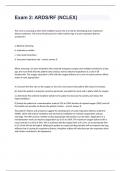
-
Exam 2: ARDS/RF (NCLEX) questions and answers graded A+
- Examen • 25 páginas • 2024
-
Disponible en paquete
-
- 17,49 €
- + aprende más y mejor
Exam 2: ARDS/RF (NCLEX)The nurse is assessing a client with multiple trauma who is at risk for developing acute respiratory distress syndrome. The nurse should assess for which earliest sign of acute respiratory distress sysndrome? a. Bilateral wheezing b. Inspiratory crackles c. Intercostal retractions d. Increased respiratory rate - correct answer D When assessing a 22-year-old patient who required emergency surgery and multiple transfusions 3 days ago, the nurse finds that the patien...
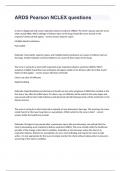
-
ARDS Pearson NCLEX questions well answered 2024
- Examen • 5 páginas • 2024
-
Disponible en paquete
-
- 10,87 €
- + aprende más y mejor
ARDS Pearson NCLEX questionsA client is diagnosed with acute respiratory distress syndrome (ARDS). The client's spouse asks the nurse what caused ARDS. Which etiology of indirect injury to the lungs should the nurse include in the response? (Select all that apply.) - correct answer Systemic sepsis Multiple blood transfusions Pancreatitis Rationale: Pancreatitis, systemic sepsis, and multiple blood transfusions are causes of indirect injury to the lungs. Smoke inhalation and fat embolisms a...
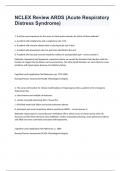
-
NCLEX Review_ARDS (Acute Respiratory Distress Syndrome)questions with answers 2024
- Examen • 12 páginas • 2024
-
Disponible en paquete
-
- 15,13 €
- + aprende más y mejor
NCLEX Review_ARDS (Acute Respiratory Distress Syndrome)1. It will be most important for the nurse to check pulse oximetry for which of these patients? a. A patient with emphysema and a respiratory rate of 16 b. A patient with massive obesity who is refusing to get out of bed c. A patient with pneumonia who has just been admitted to the unit d. A patient who has just received morphine sulfate for postoperative pain - correct answer C Rationale: Hypoxemia and hypoxemic respiratory failure are...

¿Cómo lo hizo? Vendiendo sus recursos de estudio en Stuvia. Pruébalo tu mismo. Descubre todo sobre cómo ganar en Stuvia

